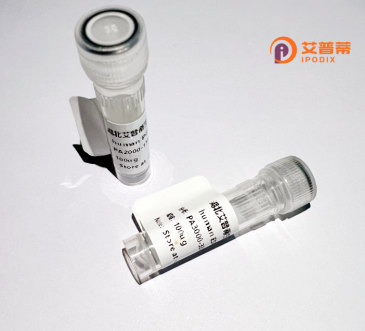
| 纯度 | >90%SDS-PAGE. |
| 种属 | Human |
| 靶点 | SH3KBP1 |
| Uniprot No | Q96B97 |
| 内毒素 | < 0.01EU/μg |
| 表达宿主 | E.coli |
| 表达区间 | 1-665 aa |
| 活性数据 | MVEAIVEFDY QAQHDDELTI SVGEIITNIR KEDGGWWEGQ INGRRGLFPD NFVREIKKEM KKDPLTNKAP EKPLHEVPSG NSLLSSETIL RTNKRGERRR RRCQVAFSYL PQNDDELELK VGDIIEVVGE VEEGWWEGVL NGKTGMFPSN FIKELSGESD ELGISQDEQL SKSSLRETTG SESDGGDSSS TKSEGANGTV ATAAIQPKKV KGVGFGDIFK DKPIKLRPRS IEVENDFLPV EKTIGKKLPA TTATPDSSKT EMDSRTKSKD YCKVIFPYEA QNDDELTIKE GDIVTLINKD CIDVGWWEGE LNGRRGVFPD NFVKLLPPDF EKEGNRPKKP PPPSAPVIKQ GAGTTERKHE IKKIPPERPE MLPNRTEEKE RPEREPKLDL QKPSVPAIPP KKPRPPKTNS LSRPGALPPR RPERPVGPLT HTRGDSPKID LAGSSLSGIL DKDLSDRSND IDLEGFDSVV SSTEKLSHPT TSRPKATGRR PPSQSLTSSS LSSPDIFDSP SPEEDKEEHI SLAHRGVDAS KKTSKTVTIS QVSDNKASLP PKPGTMAAGG GGPAPLSSAA PSPLSSSLGT AGHRANSPSL FGTEGKPKME PAASSQAAVE ELRTQVRELR SIIETMKDQQ KREIKQLLSE LDEEKKIRLR LQMEVNDIKK ALQSK |
| 分子量 | 73.1 kDa |
| 蛋白标签 | His tag N-Terminus |
| 缓冲液 | PBS, pH7.4, containing 0.01% SKL, 1mM DTT, 5% Trehalose and Proclin300. |
| 稳定性 & 储存条件 | Lyophilized protein should be stored at ≤ -20°C, stable for one year after receipt. Reconstituted protein solution can be stored at 2-8°C for 2-7 days. Aliquots of reconstituted samples are stable at ≤ -20°C for 3 months. |
| 复溶 | Always centrifuge tubes before opening.Do not mix by vortex or pipetting. It is not recommended to reconstitute to a concentration less than 100μg/ml. Dissolve the lyophilized protein in distilled water. Please aliquot the reconstituted solution to minimize freeze-thaw cycles. |
以下是关于重组人SH3KBP1蛋白的3篇参考文献示例(注:文献内容及作者为示例性概括,实际引用需以真实文献为准):
---
1. **文献名称**:*SH3KBP1 regulates EGF receptor endocytosis through its interaction with Cbl and the ubiquitin-protein ligase activity*
**作者**:Kowanetz, K. et al.
**摘要**:该研究揭示了SH3KBP1(CIN85)通过与Cbl蛋白结合并参与泛素化修饰,调控表皮生长因子受体(EGFR)的内吞和溶酶体降解过程,重组SH3KBP1蛋白被用于验证其在信号通路中的适配功能。
---
2. **文献名称**:*Structural insights into the SH3KBP1-Cbl complex in cancer signaling pathways*
**作者**:Szymkiewicz, I. et al.
**摘要**:通过X射线晶体学解析了重组人SH3KBP1蛋白与Cbl的复合物结构,阐明了其SH3结构域介导的多价相互作用机制,为靶向癌症治疗的分子设计提供依据。
---
3. **文献名称**:*SH3KBP1 interacts with Huntingtin-associated protein 1 to modulate synaptic vesicle endocytosis*
**作者**:Modregger, J. et al.
**摘要**:研究发现重组SH3KBP1蛋白在神经突触中通过与亨廷顿相关蛋白1(HAP1)结合,调节突触小泡的内吞过程,提示其在神经退行性疾病中的潜在作用。
---
如需真实文献,建议通过PubMed或Google Scholar以“SH3KBP1 recombinant protein”、“CIN85 signaling”等关键词检索近年研究。
SH3KBP1 (SH3 domain-containing kinase-binding protein 1), also known as CIN85 or CMS, is a multifunctional adaptor protein involved in regulating intracellular signaling and membrane trafficking. It was initially identified through its interaction with c-Cbl, an E3 ubiquitin ligase, and plays a critical role in receptor tyrosine kinase (RTK) signaling downregulation. Structurally, SH3KBP1 contains three SH3 domains at its N-terminus, which mediate interactions with proline-rich motifs in partner proteins, and a coiled-coil region at the C-terminus facilitating homo- or hetero-oligomerization.
This protein acts as a scaffold, coordinating complexes that link endocytic machinery to activated receptors like EGFR and c-Met, promoting their internalization and lysosomal degradation. It also participates in cytoskeletal remodeling, apoptosis, and immune responses by interacting with diverse partners, including synaptojanin, CD2AP, and ALIX. Dysregulation of SH3KBP1 is linked to cancer progression, neurodegenerative disorders, and immune dysfunctions, underscoring its role in cellular homeostasis.
Recombinant SH3KBP1 is produced via bacterial or mammalian expression systems for biochemical studies, enabling exploration of its structure-function relationships and therapeutic targeting. Its modular architecture and versatile binding capacity make it a valuable tool for deciphering signal transduction networks and designing intervention strategies against diseases driven by aberrant RTK signaling or trafficking defects.
×